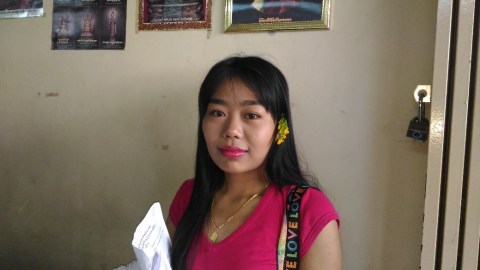2018 Activity Report
March News from the Yangon Japanese Classroom
31 March 2019
Global Japan Office Coordinator
IMAI Michiko
From April 13-17, the Thingyan Water Festival will be celebrated in Myanmar, during which the entire country has a holiday. The university will also have a holiday, so many students will return home and I can’t celebrate Thingyan with them. Due to this, I decided to celebrate with my students a month early at each university. At the University of Yangon, we celebrated on March 4.
The students set up a table in the courtyard of the literature department, and were busy doing something there all morning. Just as I was wondering what they were doing, two students from the Japanese class brought me freshly baked sweets. They gave me mont lone yay paw, a traditional sweet that is eaten during this festival. Mont lone yay paw are made with glutinous rice, but taste similar to shiratama dango as they have a sophisticated subtle flavor. They were delicious and I ate them very quickly. Apparently it is custom to put chili peppers inside some of them, and whoever picks those ones is considered to be lucky. Maybe it’s because I’m Japanese, but I thought it was strange to put chili peppers inside something that tastes as good as shiratama dango. I asked the students why they do this, and they said “because it’s fun”. I, unfortunately, didn’t get one with chili peppers in it, but I ate them all voraciously.
When I was walking through the university after work, I came across some students celebrating this festival. There was a stage set up with a DJ playing music (it was a bit too loud for older people) which the students excitedly surrounded, and a hose was used to spray water from above, which made the crowd dance wildly. The students had their hands up and were dancing their hearts out. There was a sign at the entrance saying that dancing was allowed, but throwing colored powder was not, so you can imagine how the young people usually celebrate. After this over the top celebration period ended, we dove straight into the final exams.
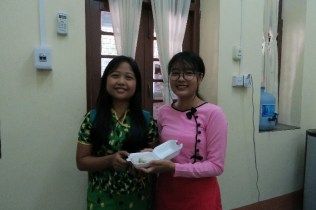
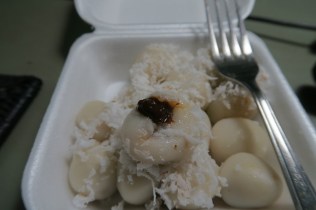
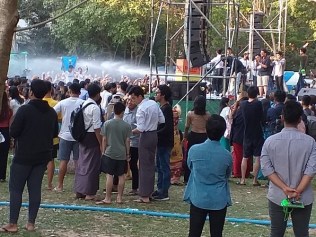
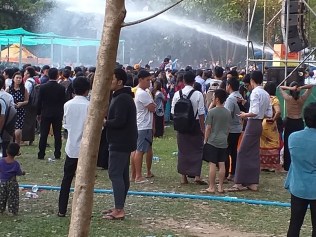
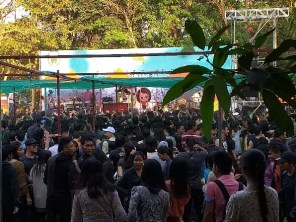
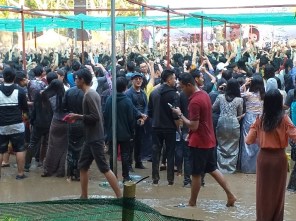
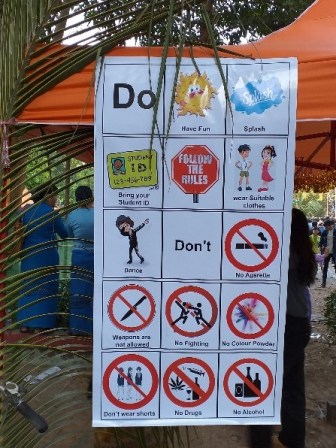
February News from the Yangon Japanese Classroom
28 February 2019
Global Japan Office Coordinator
IMAI Michiko
From December 2017, all first year student classes have been taught at the University of Yangon’s Hlaing campus, which is a little far away from the regular campus. The Hlaing campus is a 40-minute walk from the usual Kamayut campus, or 15-20 minutes by bus. It is quite tiring teaching classes and then switching campuses, especially if it is during the rainy season (buses are affected by the rain, and sometimes it rains so heavy that you can’t go outside and I have had to cancel my next class). Because of this, from December 2018 I decided to change the timetable for the GJO Yangon’s LEVEL 1 course so they have class on one weekday and on Saturday each week.
I wanted to hear what the students thought of this change, so I had them fill out a survey. I made the survey in English, and then asked a Burmese friend of mine to translate it into Burmese. I handed out these surveys during class on February 22 and 23. I’d like to share the results of this survey with you.
I surveyed both classes over the two days. Around 56 students participated. This survey was anonymous, and even though I put a column for them to write their major and year, two students didn’t write their major, and three didn’t write their year. Looking at the participants’ majors, there were 34 humanities students, 20 sciences students, and 2 unknowns. Looking at their year-levels there were 10 first-years, 25 second-years, 4 third-years, 10 fourth-years, 4 others (fifth-year students and postgraduate students), and 3 unknowns. I thought there would be far more humanities students, but the ratio was 3:2. Second-year students make up almost half of the group, and I think this is because many students don’t hear about the existence of the GJO Yangon until a year after they start their studies.
Now let’s move on to the actual survey questions. The first question was “What day do you prefer to have class on? Please choose from the following: A. Two weekdays, B. One weekday and Saturday, C. Any of the above.” 12 students answered A, 37 answered B, and 7 answered C, so I think from next semester I will hold class on one weekday and Saturday every week. I chose these options after asking what days were convenient for the first-year students, and since eight of the 10 first-year students chose B, I think it should be fine.
The second question was “How did you find out about this course?” The possible answers (and their results) were “A. Through the GJO Yangon’s Facebook page” (8 students), “B. Through a friend” (21 students), “C. Through a friend who studied at the GJO Yangon” (12 students), “D. Through a professor in my department” (12 students), and “E. Other” (3 students). B and C made up over half of the responses, so it seems that most people hear about us through their friends. While our recognition through Facebook is still low, we have had many more friend requests since December, and now have over 500 friends on the platform, so I think more people will answer “A” next year. While I thought only professors from the Literature department (where the GJO Yangon is located) would recommend us to their students, the results surprisingly showed that students heard about us from professors of six different departments (physics, computer science, geography, international relations and anthropology).
The third question was “Why are you taking this course?” The possible answers and results (in brackets) were as follows. “A. I want to be able to speak Japanese” (46 students), “B. I am interested in Japan (manga, anime, food, the country etc.)” (33 students), C. “Because it is free” (8 students), “D. Because it is on campus in a convenient place” (26 students), “E. Because it is run by a Japanese university” (10 students). I thought more students would answer with “C”, but it seems that most of them don’t have financial problems. While not many people chose “E”, from what I’ve heard students say, I think this was because most of them don’t known that this course is run by TUFS. When my next new class begins later this year in December, I think I will emphasize TUFS’ involvement.
The last question was “What is your Japanese language learning goal?”. The results were: “A. I want to be able to have everyday conversations with my friends in Japanese” (11), “B. I want to be able to use Japanese at work” (45), and “C. I want to be able to understand Japanese TV shows, films, anime, etc.” (14). I let students tick multiple boxes for this questions, but I didn’t expect majority of the students to be studying Japanese for their future careers. Perhaps this means Japanese companies and Japanese partners are considered prestigious by students at the University of Yangon?
This time around, I didn’t have much time, so I could only ask them basic questions, but next time I would like to spend more time preparing the surveys so I can analyze more interesting results.
The picture below is of the LEVEL 1 students and the student teachers.
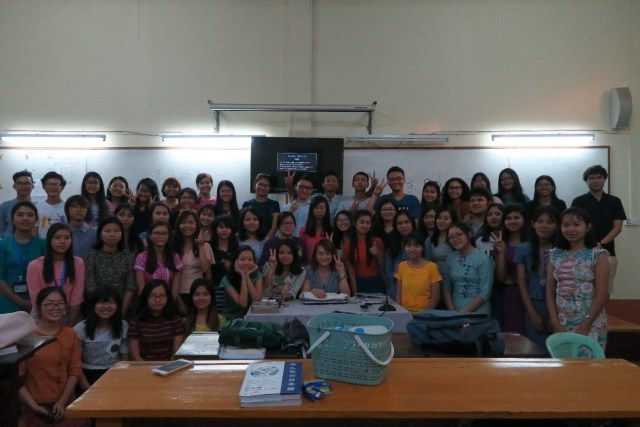
January News from the Yangon Japanese Classroom
31 January 2019
Global Japan Office Coordinator
IMAI Michiko
This year, we once again borrowed calligraphy equipment from the Japanese Embassy in Myanmar to do kakizome (the first calligraphy of the year).
There were many more participants than last year, with a combined total of 19 students from the LEVEL 3 and LEVEL 5 classes. Also similar to last year, a TUFS postgraduate student studying Japanese language education led this event, teaching the students about the tools and rules of calligraphy, and demonstrating how to write kanji appropriate for their levels.
Last year we limited the kanji to those appropriate for kakizome, but this year we left everything up to the student teacher, so the students ended up writing whatever words they liked. As expected of this generation, the students looked up the Japanese translations of their favorite words on their phones. The students had the student teacher write samples of these words and, after writing a few practice pieces, chose their favorite word to write a final copy. Some picked one word from the start and practiced it over and over again, and it was really interesting to see how this activity brought out their personalities.
This year, unlike last year, the students chose many different words. The LEVEL 3 students chose the kanji for happiness, fame, love, family, health, fireworks, health (a different kanji), laugh, hope and human. The LEVEL 5 students chose the kanji for math (I’m not sure why they chose this one), brave, truth, Meiji (this student is interested in history), Hazuki (one student’s Japanese name), education, hope and wild boar. While the LEVEL 3 students chose kakizome-appropriate words, the LEVEL 5 students chose rather unique words. This was interesting as it showed differences in the personalities of each class.
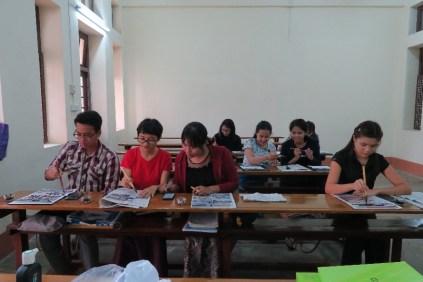
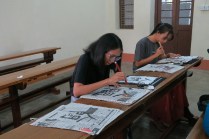
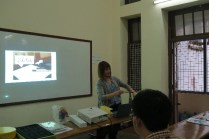
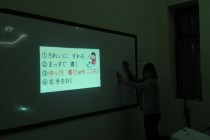
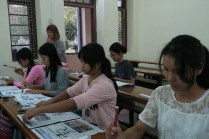
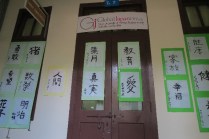
December News from the Yangon Japanese Classroom
31 December 2018
Global Japan Office Coordinator
IMAI Michiko
In December, the new semester began. At the GJO Yangon, the absolute beginner Japanese class has begun. This year, 241 students signed up for LEVEL 1, which is the highest number of students in the history of the GJO Yangon. I wonder why the number of students increased this much?
– Did the students finally realize the GJO Yangon Japanese classes exist?
– Is Japanese becoming a popular subject in Myanmar?
– Is it because the top students in the Japanese classes can go to Japan on a 10 day training course?
These are the only reasons I can think of.
I am happy and grateful that so many students want to study Japanese, but it is impossible to teach a class of 240, so for now I split them into two classes of 120. However, from a language teaching perspective, these classes are still too big.
I put a lot of effort into preparations including obtaining enough classrooms and materials, but at the orientation on December 7, numbers dropped to 188! Where did those other 50 people go? When classes actually began, only 150 people ended up enrolling in the course. By the last class of 2018 on December 29, there were only 83 students left between the two classes. In less than a month, 100 more students dropped the class. Every year, regardless of whether the class started with 70 or 100 people, for some reason there are always only 30 left by the time the final exam rolls around in March. I wonder if this will happen again this year.
The word order of Burmese is the same as in Japanese, and quite a lot of the grammar is similar, so it is quite an easy language for Burmese people to learn, but it is still difficult due to the written aspect of Japanese. While hiragana and katakana are an afterthought for natives, they pose a problem for foreigners, and are apparently hard to learn as they look like “devil sentences”.
When I look at my students’ homework, they often write unrecognizable shapes instead of す (“su”), お (“o”) or む (“mu”), and ふ (“fu”) somehow looks like a jellyfish. My own understanding of hiragana gets a bit skewed from this.
If you can’t remember all the written characters, you can only get so far, so I have no choice but to get my students to memorize them. They all have fresh and young (under 20) brains, so they should be able to do this. I try to wrinkle their brains as much as I can.
The photo below is of my admirable students who came to my class at the end of the year on December 29.
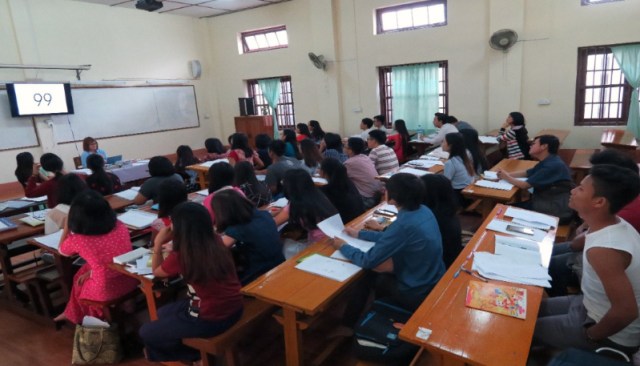
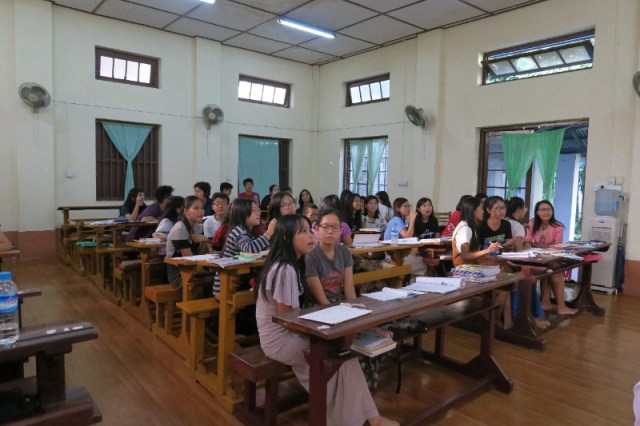
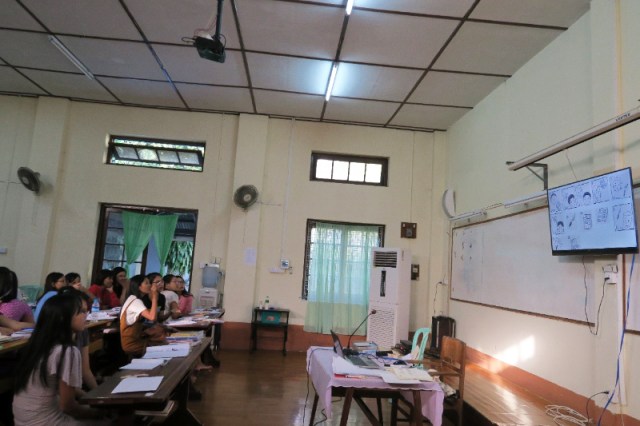
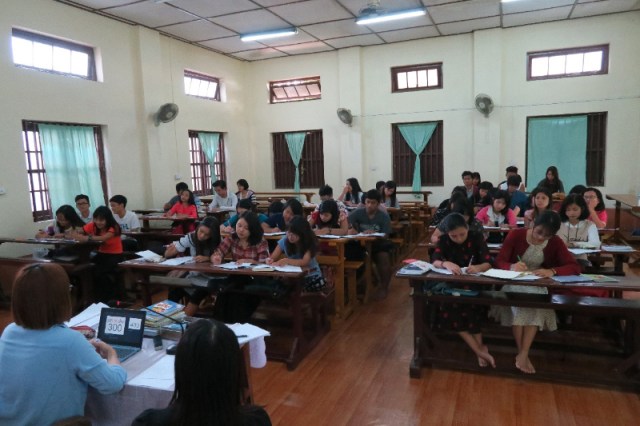
November News from the Yangon Japanese Classroom
30 November 2018
Global Japan Office Coordinator
IMAI Michiko
This year, as in previous year, three students from the University of Yangon are on exchange at TUFS. This year, all three of these students previously studied Japanese at the GJO Yangon. I interviewed two of these students, Su Wint mon and Hnin Eaint Wai, who are both students of the literature department. I want to share some of their answers with you. I conducted this interview through Facebook Messenger’s voice recording function.
S= Su Wint Mon, H= Hni Eaint Wai
- Tell me about a week in your exchange life.
S: I study at the university from Monday to Friday. I usually prep for the next day at home.
H: Monday to Friday my classes usually last from 8:30am to 5:30pm. I study both Japanese and English. On Wednesdays I only have one class.
- What do you do on your days off?
S: I go around Tokyo with my Japanese and Burmese friends. I’ve been to Shibuya, Shinjuku, and I even went to the giant Buddha in Ushiku. I’m Buddhist, so I wanted to see a large Buddha statue.
H: I do my homework, clean my room, hang out with my friends, or visit famous places in Tokyo. - Has your impression of Japan changed since you came?
S: Before I came to Japan, I thought Japanese people didn’t really think about others. But I now know that they in fact do.
(Note: It seems that Su Wint Mon wanted to buy a cake for his friend, and when he asked a Japanese person where he could buy a good one, they went and bought it for him.)
H: It hasn’t changed.
- What do you think is difficult about Japanese, and what is your personal weakness concerning Japanese.
S: Reading sentences. This is because of difficult kanji. Reading kanji is hard as they have both onyomi and kunyomi.
H: Kanji. Even if I know the meaning, I don’t know how they sound. When I try to write them myself I can’t do it.
- What is the most memorable experience you’ve had these past two months (the two months since you came to Japan)?
S: I realized that Japanese people will line up anytime for anything. They even line up for ramen.
H: The Gaigosai festival. In one of the language plays, I heard Japanese people speaking Burmese, and I thought it was cute. I also participated in the Burmese play.
- What do you want to do in Japan before you go back to Myanmar? Where do you want to go?
S: I want to go to Kyoto. I heard there are many shrines there. And I heard from Japanese people that it’s a comfortable place to live. My Japanese friend loves Kyoto and goes every year.
H: I want to go on a solo trip. I can’t travel alone in Myanmar because my parents won’t let me. But Japan is safe, so I want to travel on my own.
I want to go to Okinawa. I heard that the beaches are beautiful and the food is really good. I also think the houses and dances of Okinawa are interesting.
- What is your final language-learning goal before you return to Myanmar?
S: I want to get N2 of the JLPT (Japanese Language Proficiency Test).
H: I want to pass N1 of the JLPT (Japanese Language Proficiency Test).
These two students studied Japanese diligently before going to Japan, so it seems they didn’t have many troubles in their everyday lives, but it seems that kanji was a struggle, just as I expected. It is something even I worry about as a teacher. It’s a problem as, if you push too much kanji on the students, they’ll reject it and lose interest in Japanese, and there aren’t many opportunities for students to see these kanji in their daily lives in Myanmar, so they’ll forget them anyway.
I think that a person’s love for another country is greatly influenced by their experiences in that country, and with the peoples they meet from said country. Su Wint Mon’s impression of Japanese people “not thinking about others” is interesting, as it was probably formed from a number of things such as her own environment, differences in the concept of kindness for Burmese and Japanese people, and differences in how they deal with other people. I have lived in three different Southeast Asian countries, and I have been surprised, delighted, impressed and angered by the different patterns concerning actions and reactions of people from each country. Little by little, I deepened my understanding and empathy of these differences, and sometimes I just gave up (personally, I think there is sometimes an uncontrollable spiritual gap). While this is simply my own limited experience, I also have both good and bad impressions of people from different countries, and these change as I have new experiences with them. Su Wint Mon is currently in the midst of her own new foreign culture experience. I am looking forward to seeing how her impression of Japanese people will change from “lining up for anything” to something new.
October News from the Yangon Japanese Classroom
31 October 2018
Global Japan Office Coordinator
IMAI Michiko
There are no classes in October, so there were no Japanese classes at the GJO Yangon either. I wanted some new realia (ordinary objects that can also be used as educational materials) for the next semester, so I went to the city.
On my way to the city, I saw that there were several signs inscribed with “PARK RULE” around Inya Lake, which is located a little north of the university.
Inya Lake is an artificial lake that was made during the British Colonial period, and is now a popular recreational area for locals. During the day there is no shelter from the direct sunlight, so not many people stick around, but many people come to walk, exercise, socialize, and generally do as they please, in the early mornings, warm evenings and cool nights.
The signs at Inya Lake depict illustrations of six different prohibited actions, and are perfect material for practicing the Japanese grammar structure, “please don’t ___”. I quickly took photos to use for my classes.
Top-left: “Please don’t fish”. The men working at the foreign teacher’s dorm are so obsessed with fishing. They said they often fish at Inya Lake.
Top-right: “Please don’t swim”. I think it would be suicide to swim in a lake with this level of water quality, but apparently some people do.
Center-left: “Please don’t ride motorbikes”. It seems people obey this one.
Center-right: I think this one says “Please don’t date” or “Please don’t kiss”. If it means the former, no one is obeying it. In reality, Inya Lake is very famous for being a popular date spot among young people.
Night after night, you can see happy couples on dates along the embankment.
Bottom-left: Either says “Please don’t play music (loudly)” or “Don’t play instruments”. This rule is also ignored. I saw a young man playing guitar, surrounded by his group of friends and snuggling couples.
Bottom-right: “Please don’t sell items”. On the road that goes along the embankment, I saw people selling sweets, light snacks and balloons.
Having to ban something means there are people doing these things. I wonder how my students feel about these rules? I wonder if they themselves break them? I think I’ll ask them after we practice the grammar structure.


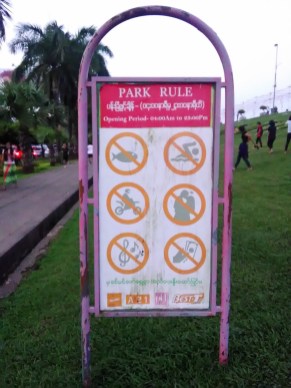
September News from the Yangon Japanese Classroom
30 September 2018
Global Japan Office Coordinator
IMAI Michiko
In September, the academic year came to an end, and a closing ceremony for exchange students was held on September 7. The four Burmese majors form TUFS, who helped interpret and support the GJO’s Japanese classes, were able to successfully complete their exchanges. At the closing ceremony, the male student gave a speech in Burmese on his achievements during his one-year exchange, and the three female students dressed up in beautiful traditional clothing and performed a Burmese dance, which received a lot of cheer from the audience. Please take a look at the photos of them below.
On September 5, a presentation was held to showcase the results of tandem learning between students studying in the GJO’s Japanese classes and TUFS Burmese majors on the short-term exchange at the University of Yangon. The students talked about food and history together, conducted surveys and gave presentations. There are photos of this event below. The Japanese students talked about Myanmar in Burmese, and the Burmese students talked about Japan in Japanese. This year, some groups gathered together of their own volition outside of the Wednesday class to discuss their presentations. Some Burmese students even skipped or came late to the Japanese classes so they could gather and discuss their tandem learning presentations. I’m not sure if I’m happy or shocked at how much effort they put into this program. I think this tandem learning experience was very significant for the Burmese students. It also undoubtedly increased their motivation to study Japanese. For that I am thankful!
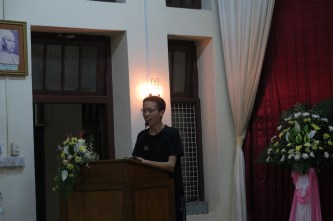
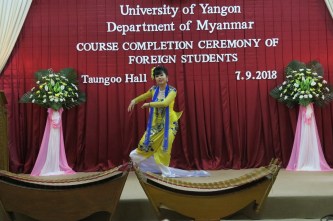
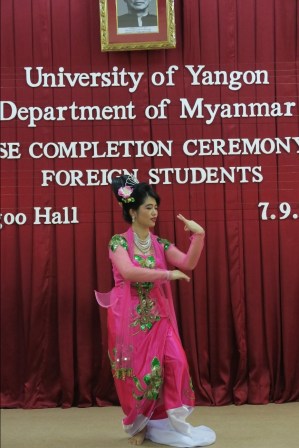
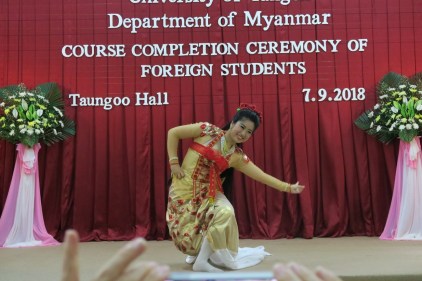
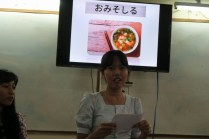
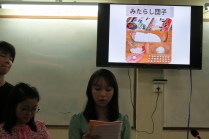
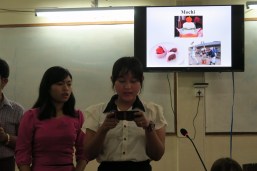
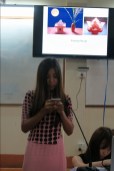
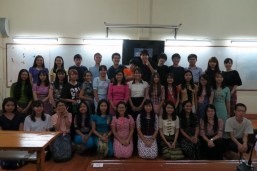
August News from the Yangon Japanese Classroom
31 August 2018
Global Japan Office Coordinator
IMAI Michiko
At Burmese universities, final exams for the second semester are held from mid to late September. Non-regular subjects, including the GJO Yangon’s Japanese classes, hold exams slightly earlier in early September. As a show of the Japanese knowledge accumulated until now by students in my LEVEL 4 class, who finished the textbook at the end of August, I had them give speeches to the topic of “my future”. I gave them this assignment on Monday, and they gave the speeches on Friday that week. I think it was tough for the students, as they didn’t have the weekend to take time to prepare their speeches, but they gave it their best. Since it’s nearing the end of the semester, six students couldn’t attend due to exams for their major subjects, farewell parties, and sickness (either themselves or their families).
My students have many dreams for their futures: becoming a teacher, working in Japan, travelling the world, eating food from many different countries, working at the embassy, becoming famous, studying many languages, studying animation, managing a company, becoming a billionaire, buying things for their parents, buying a house in Shan State (a cool northern state of Myanmar), and growing strawberries. They have so many dreams, and so much ambition and hope, I am very envious of them.
One thing that I already knew from conversations during class is that students studying Japanese have a strong desire to go overseas. It is more difficult for them to travel overseas than it is for Japanese people, as they have economic and visa-related problems, but I am glad they have these dreams. They’ve made me think that having this dream is a greater happiness than having money and no visa problems, but not wanting to go anywhere. At the end of the class, I taught them the phrase “I hope your dreams come true”. In a few years, these students will go out into the world, and I hope they keep ahold of their dreams. I also hope that their dreams come true someday.
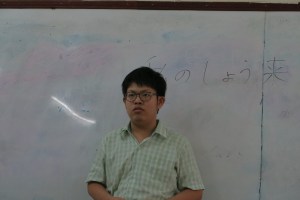




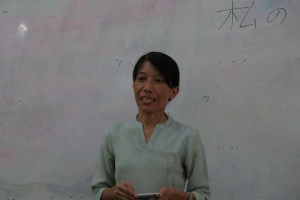
July News from the Yangon Japanese Classroom
31 July 2018
Global Japan Office Coordinator
IMAI Michiko
A few days ago, while a tad early, we had our 3rd Tanabata (Star Festival) at the GJO Yangon. In my first year as coordinator, I had only just arrived and hadn’t settled yet, so I didn’t even have time to teach my students about Tanabata, and in my second year I completely forgot about it until early July, so this year I made sure to prepare the bamboo.
At the end of June I started researching where I could get bamboo, and I discovered that there is a lot of good-sized bamboo growing around the campus. After searching high and low, I found the bamboo growing in front of the campus church the most convenient. I asked one of the exchange students to interpret for me with the caretaker in the photo below, who cut off a branch for me.
Same as last year, I got the LEVEL 2 and LEVEL 4 students to write their wishes on tanzaku (rectangular cards). Also like last year, most students wrote “to become good at Japanese”, “to live in Japan”, “to go to Japan”, “to travel abroad” and “for my parents to be healthy”. Some students even wrote the names of their favorite Korean celebrities, with their wishes saying things such as “to meet ___” and “to go to ___’s concert”. While I’m sad they didn’t write the names of Japanese celebrities, young celebrities in Japan are losing popularity to Korean ones, so I suppose this can’t be helped. Next year I hope students write the names of Japanese celebrities on their tanzaku. There were also a few surprising wishes this year, such as “to become Japanese” (perhaps they want to change their nationality?), “to become a successful person” (this is ambitious, I love it), and “to be able to buy a cellphone”.
Since I was able to get a bamboo branch this year, the LEVEL 4 students were very happy and said “this year we’re having a real Tanabata”, which made me very happy too. However, the bamboo branch for the LEVEL 2 class was quite thin, and since there are a lot of students the tanzaku were heavy. Because of this, it was difficult for students to hang their wishes on the branch, and it actually snapped once everyone had put their wishes on it. Next year I will make sure I get a thicker branch.
I hope that everyone’s wishes come true.
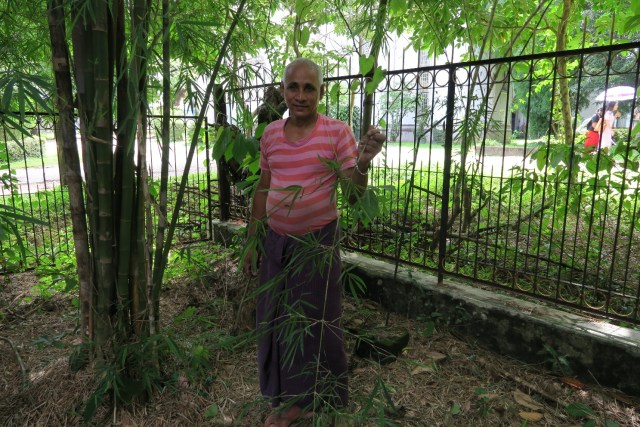
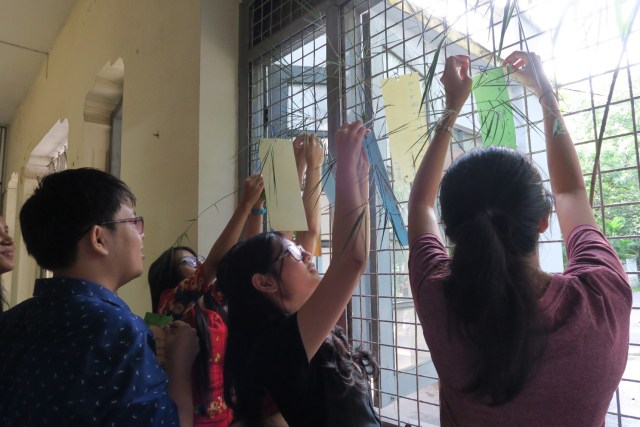
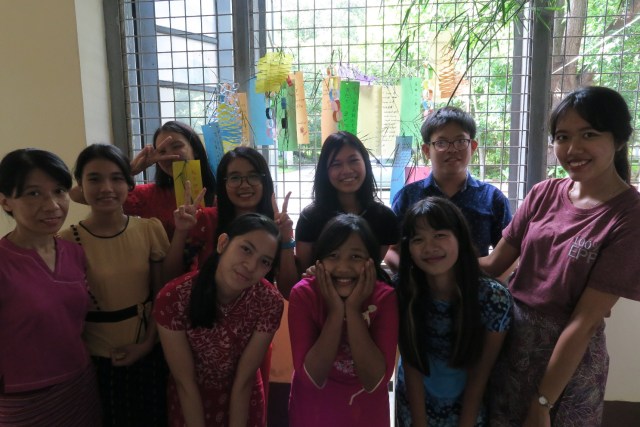
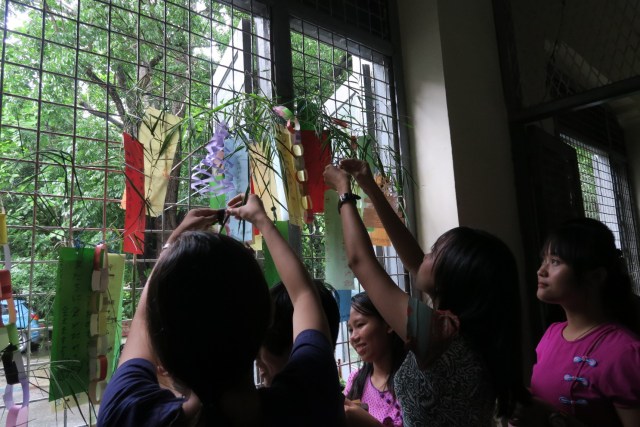
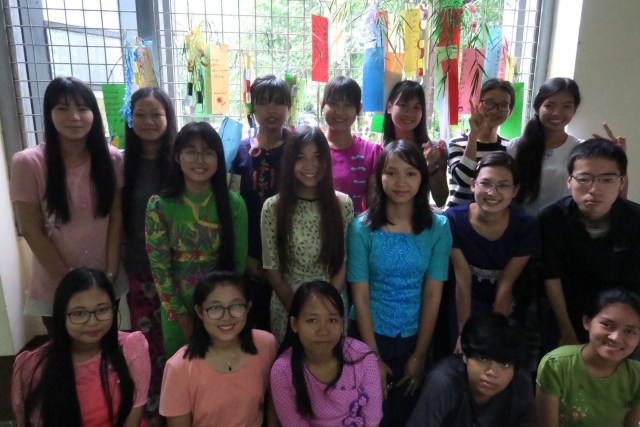
June News from the Yangon Japanese Classroom
30 June 2018
Global Japan Office Coordinator
IMAI Michiko
Every year, a short-term Joint Education Program is held as part of the “TUFS Japan Specialist Program for the Enhancement of Japanese Language and Cultural Outreach in Myanmar, Laos and Cambodia”, one of TUFS’ Inter-University Exchange Projects. This year, the program’s third year, five students studying in the Japanese Classroom at the University of Yangon will visit Japan in mid-July. During their stay they will take various classes at TUFS, and experience Japanese society by staying with a Japanese family. The five students who have been chosen to participate in this program have been very excited the last few months. However, this program is not all fun and games. On the second day of this program, the students have to give a presentation comparing Japan and Myanmar. When I told them this at the start of June, their faces changed in an instant, and I could see how nervous they all were. The students were dealt an additional blow by the program coordinators in Tokyo, who instructed them to give these presentations mostly in Japanese (with the difficult parts in either Burmese or English), which made them worry even more.
The Japanese classes at the University of Yangon are held after regular classes have finished for the day, so the time students have there is quite limited, and their Japanese is still at the early end of the beginner level. While it is impossible to give an entire presentation in Japanese at this level, if the contents of their presentations are well-prepared, and the amount of effort they put in can be seen, I think the Tokyo coordinators will be satisfied. So this month I did my best to not disturb these students’ preparations, and sat back to observe. In the last week of June, the students asked me to watch their rehearsal and give feedback. As I had expected, it was disastrous to the extent where I wanted to cover my eyes, and I was at a loss as to why I even gave feedback. I more or less told them what didn’t work, and hinted at what they needed to improve on. Unfortunately, we don’t have enough time to do another rehearsal before they go to Japan, so I’m not sure if they made any improvements before the presentation in Tokyo.
Focusing on the good points of this presentation, it is impressive that the students made it by themselves without the help of any teachers. There was no trace of someone else’s ideas (which is quite a great feat), and I think the students should be proud of themselves for researching the topic, structuring the presentation, writing the draft and presenting it. Regardless of the result, I think it was definitely a good self-study experience for them. I would like to thank TUFS and the Inter-University Exchange Project for giving my students this opportunity. Thank you very much.
However, I do imagine that the Japanese audience will probably have confused looks on their faces during the presentation...
May News from the Yangon Japanese Classroom
31 May 2018
Global Japan Office Coordinator
IMAI Michiko
There were no classes in May, so, as a continuation of last month’s report, I would like to talk about life in Myanmar.
Myanmar enters the New Year in mid-April. The New Year’s holiday begins on April 13, and the New Year begins on April 17, so people can take paid leave during this time. After the New Year you can occasionally see people with shaved heads walking around in regular clothing (as opposed to kasaya). This is because the religious people of Myanmar use the New Year’s holiday to temporarily become Buddhists, hence the shaved heads.
While Burmese women usually have long black hair, I was surprised that so many of them cut their hair short or shave it all off during this time. To nonreligious people and half-hearted Buddhists like myself, I think this takes a lot of courage, but it makes me proud to see all the women smiling happily.
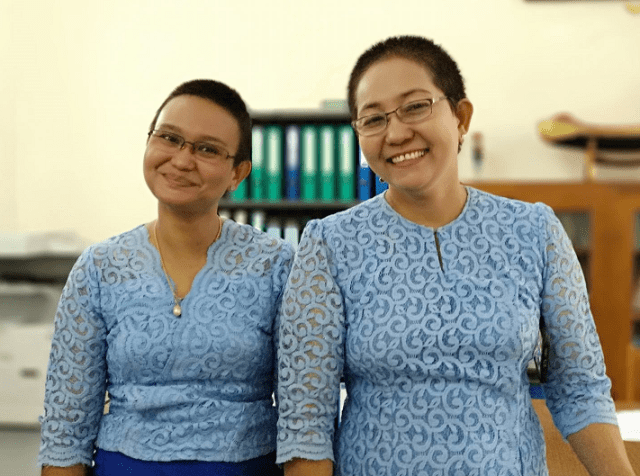
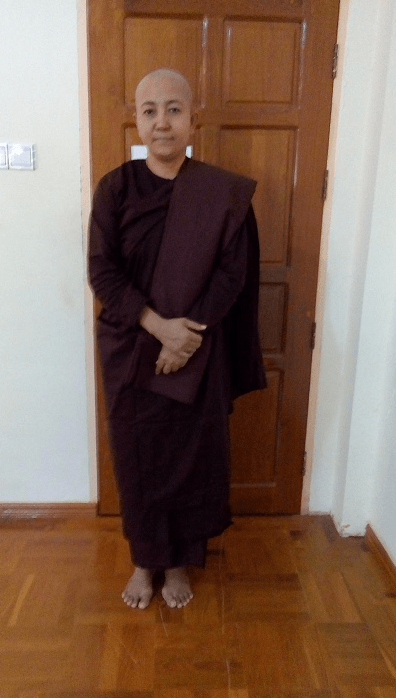
The two men in this photo are public servants working at the foreign faculty dormitory. The man on the left wanted to become a monk last year, but had to give up as he didn’t have enough money. This year, at age 46, he finally fulfilled his dream and became a monk. Becoming a monk is quite a magnificent and showy event, so I thought he would gather his family together to do it, but instead he rode a bus to a monastery near Naypyidaw, the capital of Myanmar, and did the ceremony by himself. When I asked him if his lovely wife and kids went with him, he said his wife couldn’t leave her work at the market, as it was their busiest season leading up to the New Year, and his kids also have their own jobs that prevented them from coming.
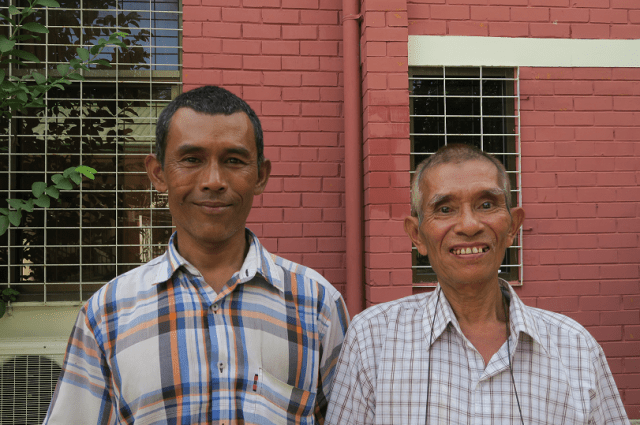
One interesting thing about becoming a monk is that the experience itself is quite different depending on the monastery and who is at said monastery during the training. These two men became monks at a monastery with no air conditioning, so I, as a nonreligious person, was very impressed. I can’t even imagine going through Buddhist training in the April heat, as even if you set the air conditioning to 16 degrees, it barely cools down and is still hot enough to cause heatstroke. However, these two men were all smiles and joy and said “it was great, I would do it again if I had enough money”.
The women in the above photos are all teachers in the University of Yangon’s Literature Department. The older woman did her training together with her mother in a room with air conditioning, but apparently there were also rooms in that monastery without air conditioning. If you look at the other photos you can see for yourself, but this monastery is a very beautiful and clean one. These two teachers said they definitely want to go again.
I thought that all religious people sought the intense heat for penance, but the monastery and rooms you can choose differ depending on your financial conditions. There were of course no air conditioners when Buddha was alive, so I suppose suffering in the heat makes you feel closer to Buddha, but it is basically self-torture… That’s how I, an average woman with worldly desires, felt anyway, and so I ended my interviews.
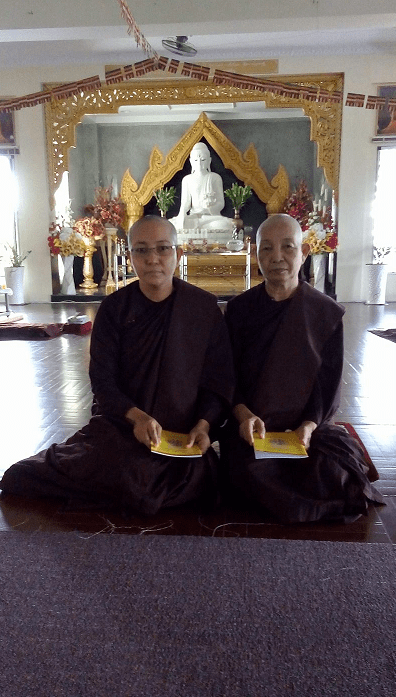
April Activity Report
4 May 2018
Global Japan Office Coordinator
Michiko Imai
Here at the University of Yangon, end-of-semester examinations ended in late March, and our long vacation began. The Yangon GJO is closed over the vacation, so this month I will write about the natural scenery of Myanmar.
At the start of April, the day after it rained heavily, I opened my door to a fragrant smell drifting through the building. It was as if an angel had come down to my dreary dormitory and blessed it with a sweet scent. When I went out, I noticed that women old and young were wearing small flowers in their hair. Whether they were wearing traditional Burmese clothing or western clothing, it was almost as if it was decided that everyone would wear flowers in their hair.
Why did everyone start wearing flowers overnight? I thought perhaps there was a festival, and so I asked the doorman of my dormitory. He informed me that the padauk flower had bloomed.
The yellow flower in the photograph below is a padauk flower, and they seem to bloom all at once every year in early spring after the first heavy rain. It seems that the blooming of the padauk signifies that the Burmese New Year is drawing closer.
The padauk in the photo were arranged on the wall of a deli stall on a street corner. I tokk this photo around noon, so the flowers were already wilting. This beloved flower of Myanmar sadly wilts just one day after it blooms. Because of this, people in the streets wear the flower and enjoy it for as long as they can.

National Flower: Padauk



